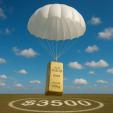Dollar benefits from OPEC decision as oil currencies slide
Frankfurt (Nov 28) The dollar strengthened on Friday after OPEC decided not to cut oil output, slamming commodity currencies like the Norwegian crown, which fell to five-year lows against the greenback and euro.
The euro slipped before data due at 1000 GMT, which is expected to show euro zone prices rose just 0.3 percent in November. That is deep in the European Central Bank's "danger zone" for inflation of below 1 percent and even further away from its target of just under 2 percent.
Investors took aim at currencies of oil-rich countries such as Norway and Canada as Brent crude tumbled to a four-year low of $71.25 after OPEC's decision. Crude is down more than 10 percent this week alone.
The U.S. dollar rallied to 6.9963 Norwegian crowns, a high not seen in over five years, up 0.9 percent on the day. The euro also hit a five-year high of 8.7080 crowns.
Against the Canadian dollar, the greenback rose 0.4 percent to a two-week high of C$1.1384.
"If oil prices remain where they are or decline further, the need to buy these currencies will be less because their exports have become markedly cheaper," said Hamish Pepper, currency strategist at Barclays in London.
"There's a very direct channel through which these currencies are impacted." The dollar rose 0.7 percent against a basket of major currencies to 88.217, leaving it on track to finish November with five straight months of losses - its best run in five years.
It strengthened against the yen, too, as Japans's core consumer inflation slowed for a third month. The dollar rose 0.4 percent to 118.24 yen.
Two-year Japanese yields fell below zero for the first time and 10-year yields reached a record low of 0.42 percent, making the yen less attractive to global investors.
The euro was down quarter of a percent at $1.24390 before the euro zone inflation data.
The focus this weekend will be on Switzerland, where voters will decide,whether the central bank should hold more gold in its reserves.
The Swiss franc stood at 1.20195 francs per euro, close to the Swiss National Bank's three-year-old cap of 1.20 francs.
Source: CNBC










